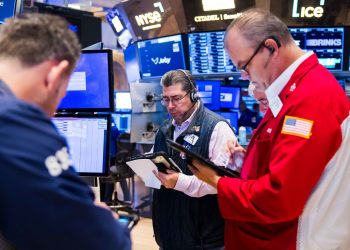Good morning. You are reading the Up First newsletter. Subscribe here to receive it in your inbox, and listen to the Up First podcast for all the news you need to start your day.
Uplifting Indigenous Stories
On the occasion of Indigenous Peoples’ Day, the First The newsletter recognizes the work NPR member stations do to elevate Indigenous voices. NPR network member stations are independent and locally operated. They set their own schedules and base their reporting on the needs and interests of their communities, many of which have large indigenous populations.
Karen Little Thunder and her cousin Phil Little Thunder greet attendees at a memorial ceremony at Ash Hollow State Historic Park in Nebraska on September 6.
Jessica Wade / Nebraska Public Media
hide caption
toggle caption
Jessica Wade / Nebraska Public Media
Lily Hope, a Lingít master weaver, uses the popular Labubu dolls to raise awareness of Chilkat and Ravenstail weaving. She dedicated her life to reviving this profession. To date, Hope has helped hundreds of Alaska Native people establish their own weaving practices. (via KTOO)
For her senior thesis, Natalie Zenk studied a Native American statue which had been part of the Cornell College art collection for over a century. But her plan quickly changed when she discovered its origins came from the Etowah Indian Mounds, a Mississippian burial site in Georgia, hundreds of miles from where the college is located in Iowa. (via Iowa Public Radio)
One hundred and seventy years ago, the American army massacred a Lakota village near Lewellen, Neb., and soldiers took dozens of possessions from the Lakota people. The historic properties were later donated to the Smithsonian Institution. After serious negotiations, these items have now been returned to the descendants of the tribe. (via Nebraska Public Media)
Andre StrongBearHeart Gaines-Roberson Jr. is a Nipmuc cultural steward who teaches traditional Indigenous arts. and advocates for indigenous communities to have access to and manage protected lands. His efforts brought attention to the diminishing supply of Atlantic white cedar in Nipmuc territory. These young cedar trees are essential for the construction of traditional dwellings of the Eastern Forest tribes. (via WBUR)
President Trump’s recent Pentagon DEI directive resulted in the erasure of the legacies of some Native American war heroes from the records of military history. Although some previously deleted photos and stories have been restored, this three-part series from KJZZ’s Gabriel Pietrorazio focuses on the impact of the administration’s actions on the families and descendants of Arizona icons Ira Hayes, Lori Piestewa and the Navajo Code Talkers.
Do you have five minutes of your time to waste? Our living lands is a weekly radio program that examines how climate change is affecting the health, culture and environment of Indigenous communities. It is run by a three-person Indigenous team, in collaboration with the Mountain West News Bureau, Koahnic Broadcast Corporation and Native Public Media.
Indigenous Peoples Day Listens

Journalist Rebecca Nagle poses next to her new book, By the Fire We Carry: The Generational Struggle for Justice on Indigenous Lands
Photo credit: Bretagne Bendabout
hide caption
toggle caption
Photo credit: Bretagne Bendabout

Journalist Rebecca Nagle poses next to her new book, By the Fire We Carry: The Generational Struggle for Justice on Indigenous Lands
Photo credit: Bretagne Bendabout
Common land: Dive into the history, science and politics behind the creation of a particular parcel of protected common land.
- 🎧 Show producer Matt Podolsky attempts to hike the Appalachian Trail with his 65-year-old mother, Candy. The two face extreme weather, illness and injury as they travel 2,200 miles from Georgia to Maine. Along the way, Podolsky shares the stories of remarkable people, fascinating history, and modern challenges facing the Appalachian Trail, all as the iconic trail celebrates its 100th anniversary.
Evergreen foliage: Listen to this audio portrait of the Pacific Northwest that features the stories of the people, places, communities and cultures that make up the region.
- 🎧 The High Desert Museum of Central Oregon’s exhibit, “Sensing Sasquatch,” is interactive and multi-dimensional. and includes larger-than-life installations. Visitors are encouraged to interact with the artworks through touch and smell. The exhibit features Native American interpretations of the being known as Sasquatch, Bigfoot, or “the big guy.” In this episode, hear from three of the artists – Charlene Moody, Frank Buffalo Hyde and Philip Cash Cash – who co-curated the exhibition.
Curious city: This WBEZ podcast answers listener questions about the Chicagoland area. Including the audience in the storytelling makes journalism more transparent and interconnected.
Code switch: The podcast explores how race affects all parts of society — from politics and pop culture to history, food and everything in between. This podcast brings us all into the conversation, because we are all part of the story.
- 🎧 In this episode, Indigenous journalist Rebecca Nagle talks about her book, By the Fire We Carry: The Generational Struggle for Justice on Indigenous Lands. The book alternates between the history of Native displacement in the United States and a Supreme Court decision that corrects some of its sins.
Direct line: Each episode goes beyond the headlines to answer the question “How did we get here?” » Sound and stories bring the story to life and put you in the middle. From ancient civilizations to forgotten figures, hosts Rund Abdelfatah and Ramtin Arablouei take you straight into the moments that shaped our world.
- 🎧 The word “reservation” implies that the land is “reserved” specifically for Native Americans. But most reservation lands are not owned by tribes. Instead, it’s mixed with private farmland, federal forests, summer camps and even resorts. This is evident for the Leech Lake Band of Ojibwe in northern Minnesota. The tribe owns only a small portion of its reservation land. But just northwest of Leech Lake is Red Lake, one of the only reservations in the country where the tribe owns all of its land. In this episode, a road trip through Leech and Red Lakes to tell the story of two tribal nationsthe moments of choice that led them down very different paths and what the future looks like from where they are now.
Internet says it’s true: Forgotten history, bizarre stories and facts that seem too strange to be true: Host Michael Kent asks his listeners to tell him something strange, bizarre or surprising that they recently learned, and he gets to the bottom of it. Each episode ends with a game show-style quiz show with a celebrity guest.
- 🎧 In 1957, an astonishing discovery was made: a Viking Penny dating from 11th century Norway. The discovery itself was rare but not unknown. What made it so remarkable? The coin was discovered on the eastern coast of Maine, United States. Listen to the incredible story of its founder.
This newsletter was published by Suzanne Nuyen.









